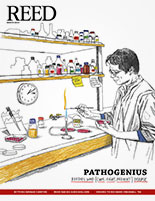
IRIS login | Reed College home Volume 92, No. 1: March 2013
Eliot Circular
Reed Shrinks Carbon Footprint
By Randall Barton
In a move that will significantly reduce its environmental impact, Reed has signed a three-year, $5.4 million contract with Ameresco Quantum to identify and implement changes that will minimize energy use, maximize equipment life, and maintain building livability.
After evaluating more than 960,000 square feet of campus buildings, AQ outlined a program of energy renewal and replacement that will yield a 12% reduction in electrical energy use, a 13% reduction in gas use, and a 28% reduction in water and sewer costs. The changes are estimated to cut operational utility costs by at least $2.7 million over the next 10 years and reduce annual CO2 emissions by 2.65 million pounds.
Work is already underway in the library, chemistry, Educational Technology Center, Eliot Hall, Vollum College Center, sports center, Gray Campus Center, and the Physical Plant. Energy Trust of Oregon is funding $300,000 of this work.
Six years ago, Reed adopted a sustainability mission statement that recognized the relationship between the campus and the planet. A committee fielded proposals—everything from building a cob bicycle shelter to investing in wind power.
“We quickly found out that there are a whole bunch of $100,000 to $200,000 things you can do that are not going to have any real impact,” says Townsend Angell, director of facilities operations. “We need to prudently manage the money that is given to Reed. We don’t really know the future of wind power. But we can invest in a piece of equipment like a boiler that works better and makes an impact we can measure.”
The committee focused on projects that would result in measurable energy savings. One is installing a new, more efficient steam boiler.
Angell says the massive old boilers are “in ridiculously good condition,” but are designed to perform optimally on 40-degree days. During the summer the big boilers are constantly starting and stopping, which consumes energy and promotes wear and tear. The smaller boiler will handle summer loads more efficiently.
The boilers provide heat for many of the older buildings on campus. By contrast, each room in the four new Grove dorms has its own thermostat, with a system that can heat one room as it cools another. Heat is harvested from parts of the building that don’t want it and delivered to parts that do.
Another interesting project involves carbon dioxide sensors in places like Kaul to notify the heating system when people arrive. The sensors estimate the number of people in the room by the carbon dioxide they exhale and adjust the air intake accordingly.
Reed has installed solar panels on the Theatre Annex, the two warehouses, Birchwood Apartments, Reed College Apartments, the Health and Counseling Center, 28 West, and the Farm, Garden, and Canyon houses. Other improvements include LEDs, low-flush toilets, water-saving showerheads, and aerating faucets.
Some institutions offset their carbon footprint by purchasing energy credits. Angell says Reed is not only authentically shrinks the carbon footprint, but reducing utility bills.


LATEST COMMENTS
steve-jobs-1976 I knew Steve Jobs when he was on the second floor of Quincy. (Fall...
Utnapishtim - 2 weeks ago
Prof. Mason Drukman [political science 1964–70] This is gold, pure gold. God bless, Prof. Drukman.
puredog - 1 month ago
virginia-davis-1965 Such a good friend & compatriot in the day of Satyricon...
czarchasm - 4 months ago
John Peara Baba 1990 John died of a broken heart from losing his mom and then his...
kodachrome - 7 months ago
Carol Sawyer 1962 Who wrote this obit? I'm writing something about Carol Sawyer...
MsLaurie Pepper - 8 months ago
William W. Wissman MAT 1969 ...and THREE sisters. Sabra, the oldest, Mary, the middle, and...
riclf - 10 months ago